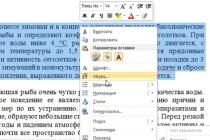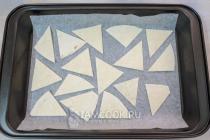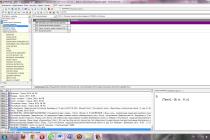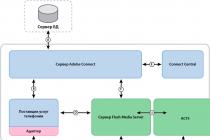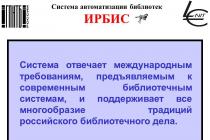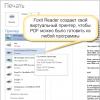Hello dear readers of the blog site. Today we will talk about another cloud service, this time from. First, some lyrics. I still have two hard disk, who are already twelve or fifteen years old, and maybe more. “So what happens,” you say. Yes, but ...
Over the past few years, I have thrown into the trash about six or seven railroad cars, which were from two to four years old, but they all failed in turn. Components now (and railways in particular) are extremely unreliable (apparently this is a conspiracy to sell more and more volumes, because the quality does not depend on the manufacturer's firm). Therefore, all important and not so important information has to be backed up. ...
Now I am using Dropbox, but the free gigabytes that I received for installing their application on my S3 mobile are coming to an end. Due to the devaluation of the ruble, the paid package almost doubled in price. So now I'm at a crossroads - either strangle the toad or look for an alternative free cloud.
Option clouds from Mail.ru I liked great for free service the size of the storage area is 25 GB (on my old account Mile.ru I even got a hundred for undivided use) and it is quite popular in the Russian Internet. However, let's take a closer look at the product ...
Opportunities of [email protected] in comparison with competitors
Previously, the corporation had a Mail.ru Files project and provided users with the ability to exchange files. Files had a number of restrictions on the size of the transferred objects and much more, but since 2014 this project is considered closed and everyone is strongly advised to move to the cloud, where all its main functionality was transferred:

Therefore, today it makes sense to talk exclusively about [email protected]. To begin with, let me remind you that a little earlier I described several popular in Runet cloud services, each of which is quite competitive (you will find them on the links provided detailed description):
- - a wonderful service (the ancestor of other clouds), which stores not only files, but also the history of their changes (this option once seriously helped me out). True, only two gigs are given for free, although you can be sophisticated in various ways, expanding them to sixteen. On a paid tariff, they give a terabyte, but they will ask in exchange for this one hundred evergreen pieces of paper a year (some kind of chaos).
- - on a free account there is a limit of 10-20 Gig, which, again, will have to be mined in various unnatural ways. I mainly use it to transfer some files (folders) using sharing, or to upload some things to download from the site (Dropbox in this regard is picky about the volume of traffic generated when downloading).
- - as in Dropbox, there is a place to save the history of document changes in the cloud, as well as a huge number of file types can be viewed without downloading them to a computer. By default, it offers fifteen gigs for free (though they will be shared with and Google photos). There you will also find an online office (what used to be Google documents) if you want to create and edit documents online.
- - the brainchild of Microsoft. Ordinary mortals are provided with seven gigs of joy, and for owners of licensed eights - twenty-five. Of the chips, we can note the complete analogy of an online office, which is called Office Web Apps, as well as the ability to remotely access a computer from the Internet where you have a cloud application installed.
Having kindly skipped ahead and introduced the competitors, I think it's time to review the capabilities of the web interface of this cloud, its software for installation on a computer and the Mail.Ru Cloud mobile application. The set is generally standard, and the capabilities of this service are somewhat similar to those already described by direct competitors.
Nevertheless, a year ago there was a promotion in Mail, according to which many managed to get one terabyte of free space in the cloud just for installing a mobile client and connecting it to their account. Therefore, in Runet, this service is very actively used, including for sharing something useful in narrow circles. In general, I like the corporation's approach to business, and I noted this when I wrote about them. It is not for nothing that, in total, all their resources rank first in terms of attendance in the Russian Internet.
Key Features of the Milestone Cloud
So which ones:

As you can see, the history of file changes is not kept here, which means that you cannot restore the appearance of the file that it had a week ago. On the one hand, this is a minus, but on the other hand, in two years I have used this opportunity in Dropbox only once.
Online version of the [email protected] file storage
Cloud web interface quite simple and concise. There is nothing superfluous and distracting. Personally, I like it more than the options of competitors (designers and usabelists have done a great job).

There are two tabs at the top: Cloud and Sharing. The first tab opens by default, and you will find a description of the second in the video above (there you can share one of the folders for your friends or colleagues and allow each of them to either only view the content, or give them the ability to edit it). Let's go over the interface of the "Cloud" tab:
Mail.Ru Cloud - programs for working with disk
Actually, let's just work with the desktop and mobile version"Mail.Ru Cloud" and go over. Let's start with the computer. You can download the program for Windows at the link provided. The setup wizard is completely "typical". After installing the program [email protected] you will be prompted to enter your username and password for the mail account:

If you entered everything correctly, then in the next step you will be offered to change your place of residence if you wish. folders [email protected] , which will subsequently be synchronized with the cloud. Please note that its size will be equal to the size of the files stored on the virtual cloud disk, and can reach 25 Gigabytes (and in my case, even a hundred).
By default, this folder is proposed to be created on the "C" drive, which for me personally is not acceptable, because I periodically create an image of it with Akronis and the extra gigabytes I did not resist there at all.

Traditionally, after installing the program, its icon will appear in the tray, by clicking on it with the left mouse button you will just get into this same shared folder, which will be synchronized with the cloud. Well, the right-click menu will allow you to perform a number of important and not-so-important actions.

For example, if you work with the same cloud from Mile from several computers (it is allowed to connect up to five of them), then surely different users will have their own folders that there is no point in synchronizing everyone else. For such a setting, use the menu item "Select folders"... In the window that opens, simply uncheck the folders that you do not need to sync the contents of on this computer. If anything, then it will be possible to play everything back by simply putting the checkboxes back in place.
now you will not need to open the cloud.mail.ru service in the browser, but it will be enough just to copy it to the folder [email protected] the necessary objects and they will immediately start synchronizing with the virtual cloud disk... By the way, in the context menu of all your files and folders after installing the program, additional items will appear to help in this difficult matter:


Well, as if on a desktop program, I don't know what else to say. Quite simple, clear and understandable. Let's see if the mobile app is doing so well.
Cloud Mail.Ru mobile application
I put it on the iPad, so I will talk about it. It is put from (search either by Cloud Mail.Ru, or by cloud Mail.ru). Naturally, you will again have to enter your username and password from the account.
After that, you will be asked if you want to automatically upload photos and videos from this gadget to the mail cloud.

If you agree, it will be automatically created at the root of your virtual disk folder "Camera Uploads" where all media files will be copied immediately. Actually, the screenshots given here I uploaded to the computer in this way. The thing is convenient.

The interface of the mobile application is again quite simple and well thought out. At the top right you will find a button for setting appearance displaying files in the window (again, the notorious tile or list you will be prompted to choose). In the same place, by the way, it will be possible to customize the sorting (alphabetically, by date and in reverse order).

The button with a plus sign located next to it will allow you to add a new folder, as well as perform a couple more actions:

The left button on the top toolbar opens a hidden menu that allows you to perform a number of actions.

I forgot to mention that the mobile application goes by itself, because the former, as a rule, lacks memory. However, some files can be stored on the gadget. The easiest way to do this is to click on the up arrow while viewing the file, but there is also universal way... In order to mock any file, it will be enough to click on the letter "i" in the circle and in the already opened window select the action you need (save, share, move, rename, etc.).

It will also be possible to configure and general access to the folder:
When viewing files in list mode, you can simply shift the line with the object description to the left and access the same settings:
Naturally, files of many formats can be viewed directly in the application window (photos, videos, text documents, etc.). Well, that's all, I guess.
As if the impression of the usability of the service and applications under the general name [email protected] I have a very good impression. If in the near future the possibility of joint work with files is also screwed up, as well as (dreams) add the ability to access the history of file changes, then I may move to this file storage from Dropbox (100 GB received from the mailbox will quite satisfy me in size) ... However, I would be grateful to hear your feedback. Maybe dissuade.
Good luck to you! See you soon on the pages of the blog site
You may be interested
ProtonMail - e-mail with increased security and interface in Russian  Email on Mail - registration, login and creation of a mailbox, as well as setting up folders and filters for incoming mail on Mail.ru
Email on Mail - registration, login and creation of a mailbox, as well as setting up folders and filters for incoming mail on Mail.ru  Email mail - registration, choosing an email address, how to enter your mailbox and how to view incoming letters on your page Email - where you can create it, how to register mailbox and choose the best free Email service Yahoo Mail - updated free mail Rambler mail (login, configuration, work with incoming) and its place among other free e-mail services Yandex Photos - free photo hosting with the ability to edit photos and upload images to the Internet Google Drive - registration, login, online drive and program capabilities, as well as 5 reasons to store files in the Google cloud
Email mail - registration, choosing an email address, how to enter your mailbox and how to view incoming letters on your page Email - where you can create it, how to register mailbox and choose the best free Email service Yahoo Mail - updated free mail Rambler mail (login, configuration, work with incoming) and its place among other free e-mail services Yandex Photos - free photo hosting with the ability to edit photos and upload images to the Internet Google Drive - registration, login, online drive and program capabilities, as well as 5 reasons to store files in the Google cloud  How to create an email - what is it, how and where to register and which email (mailbox) to choose
How to create an email - what is it, how and where to register and which email (mailbox) to choose  Acceleration and protection of your website in the cloud service Airi.rf
Acceleration and protection of your website in the cloud service Airi.rf
Recent research from analyst firms predicts that by 2016 the average household will have accumulated about 2.2 TB of digital information (Gartner), and the number of concurrently connected devices to the Internet, which, according to analysts of NPD Group, currently account for 5.7 per one household will become even larger. These trends call for new technical means to store digital content that allowed consumers to take complete control of their data from anywhere.
Personal cloud storage is a new standard for this kind of systems, which provides the ability to store media files and documents on a local home drive with access to them over the Internet from any personal digital device. WD recently introduced such a device, which it calls the WD My Cloud. With the My Cloud, users can share their files, start streaming and securely work with their data from anywhere in the world, without any subscription fees.
We tested the WD My Cloud model (WDBCTL0020HWT) with a built-in hard disk for 2 TB, let's take a closer look at the device.

The package includes the device itself, a power supply, a cable for connecting the device to local network.installation instructions software.

The My Cloud chassis is made of glossy white plastic. On the front panel there is a device activity LED.

The rear panel contains a USB3.0 connector, an Ethernet connector, a power supply connector, a Kensington-lock and a Reset button.


The My Cloud uses a Gigabit Ethernet interface and a dual-core processor to make file transfers extremely fast and dynamically update and keep data up to date.

The top surface of the My Cloud is designed as a grille to better dissipate heat from hard disk... It is worth noting that the device itself practically does not heat up and does not make noise during operation.
The hallmark of the My Cloud is ease of installation. WD software can automatically recognize the connected drive. It only takes a few minutes for the initial setup in the universal web interface. Immediately after installation, the storage becomes available for creating accounts individual users, connecting to all used computers and mobile devices using free utilities.
All installation and configuration takes place in a few steps.
Go to the WD website and download the software for WD My Cloud

Launches the installation. The program detects the device itself. In our case, the storage is connected via a WiFi router. 
We create account administrator for the repository 
That's it, the installation is complete.
After that, you get access to the device over the local network or through the wd2go.com service from anywhere with an Internet connection.

The streaming feature allows the My Cloud to be used as the central home storage for terabytes of videos and music. Any multimedia device that supports DLNA technology can be connected to the drive, - a media player, Smart TV or a game console.
Users can work with documents, view photos, and receive streaming video from the My Cloud on their smartphones and tablets using special free mobile applications. They also allow you to manage data on the device, send individual files by e-mail, provide a link to your documents, print and open files, move them from your personal cloud to public ones such as Dropbox ™, SkyDrive® and Google Drive ™.
After installing the software, the WD My Cloud dashboard shortcut appears on your desktop.

The home screen of the control panel displays basic information about the drive. As we can see, after the first launch, an icon is displayed on the control panel indicating that the device's firmware is outdated. If you click on the icon, the program will automatically update the device's firmware to the newest one.
In addition to the information displayed on the main screen, you can perform express diagnostics of the device.

In the "Users" section, you can configure access to your cloud content by setting up user accounts and access rights.


A few words about cloud software. ON WD SmartWare Automatically continually backs up data files stored on your computer to the WD My Cloud drive. SmartWare crashes first Various types files on the disk where the original files are stored, categorized. You can back up all types of files or specify specific files, folders or categories for Reserve copy... Once backed up, the WD SmartWare software protects your files by backing up:
- new files created on the computer or copied to HDD
- existing files modified in one way or another


Safepoint makes snapshots of data on disk for disaster recovery of device contents.

Options on the Options screen allow you to fine-tune your cloud storage to suit your needs.
conclusions... WD My Cloud is a very easy-to-use and inexpensive device for those who process and store large amounts of information. It can be recommended both as a family repository of music and films, and as a reliable photo archive for professional photographers. Not only can you access WD My Cloud from anywhere on Earth with an Internet connection to upload photos from a camera or laptop, the system will also take care of the safety of your data by backing up files and folders from your PC to the cloud, and at the same time will make backups of the cloud itself in case of a failure.
The name of the new WD My Cloud NAS translates to “my cloud”. Although in fact it is not quite a cloud and not even a fully fledged NAS. This is a convenient and compact backup device, a simple media server and storage device with the ability to access via the Internet for more than modest money. In terms of data transfer speeds, the My Cloud is clearly not the leader here. And with the level of reliability of a single-disk drive, where it is impossible to organize a RAID array, things are not very good. But it is not valuable for this.
How does WD My Cloud compare? For example, with the Apple Time Capsule, especially since "my cloud" has built-in support for Time Machine out of the box. Plus, the My Cloud is roughly one and a half times cheaper than the latest generation tower pod, and if you don't need a router or wireless access point, a WD drive can be a good alternative. And the snow-white body of the My Cloud will fit perfectly into the "apple" family.
A direct competitor to WD My Cloud is the Seagate FreeAgent GoFlex Home single-drive NAS, which also supports Internet dial-up, Time Machine functionality and UPnP server. FreeAgent GoFlex Home also does not set speed records, and it uses slow USB 2.0 to connect external drives, so WD My Cloud clearly wins purely for hardware.
Specifications
Built-in hard drive: 2, 3 or 4 TB with SATA interface
Interfaces: network Gigabit Ethernet, USB 3.0 (up to 5 Gb / s) for external drives
Supported operating systems: Windows XP / Vista / 7/8, OS X 10.6.8 or higher
Protocols: CIFS / SMB, NFS, FTP, AFP, DHCP, SSH, UPnP, DLNA and iTunes servers
Dimensions: 49 x 139.3 x 170.6 mm
Weight: 0.96 kg
Equipment: Category 5e Ethernet cable, AC adapter
Price: about 5200 rubles
Inside and outside
The heart of WD My Cloud is the specially designed Mindspeed Comcerto C2200 system-on-a-chip for networking devices with two Cortex A9 ARM7 cores running on clock frequency 1.2 GHz. The device also has a microcircuit random access memory DDR 1600 MHz 256 MB and flash memory module 512 MB.
Higher-end NAS's are usually not supplied with hard drives, giving the choice at the discretion of the owner. WD My Cloud, on the other hand, comes with a hard drive already installed, which is a 3.5-inch Western Digital WD Red series drive. This series includes hard drives designed for NAS'y entry level that combine from one to five drives. These hard drives with SATA 6Gb / s interface and variable spindle speed are highly reliable and are designed for 24/7 operation. Our modification of the WD My Cloud uses a 2TB model and offers 3TB and 4TB drive options.
The WD My Cloud case is traditionally designed for external drives of this brand in the form of a book: the "cover" is made of glossy white plastic, and the "block" with numerous ventilation holes is made of silver plastic. The cooling is completely passive, so the NAS is practically silent - you will only hear the quiet crackling of the hard drive. Unfortunately, different words are no longer encoded with Morse code in the casing holes, as was the case in previous generations of WD drives, here it is just a pattern.
WD My Cloud does not have any hardware controls - all commands are sent over the network. A multifunctional LED indicator of operating modes is installed on the front panel, on the back - USB port 3.0 for connecting external drives, a gigabit network port, a connector for a power supply and a reset button recessed inside the case. On the bottom panel, you can find an information plate with a serial number, MAC address and other service information, as well as four stable legs.
Software base and web interface
The software basis of WD My Cloud, like the vast majority of NAS's, is Linux, in our case we are talking about Debian Wheezy. This means that it will not be difficult for a person who understands to get into its jungle and expand the functionality of the device without making changes to its hardware. In particular, you can install the Transmission torrent client on the WD My Cloud, which we have successfully done. How exactly, a little later. To take advantage of all WD My Cloud features, including Internet access to files stored on it, you need to connect the NAS to a router and set up an account with the WD My Cloud online service. Of course, if necessary, you can connect the device directly to the computer and work with it as with a regular external drive.
All settings and management of WD My Cloud are carried out through the web interface, which can be accessed either through the shortcut that appears after installation, or simply by typing the device's IP address in the browser. If you've created a WD My Cloud account, you'll be able to access this interface on mobile devices as well as use the WD Photos app.
The fully Russified web interface is very laconic, although it contains all the settings necessary for the operation, which are scattered over five pages: "Users", "Resources", "Access to the Cloud", "Safepoints" and "Parameters". Wherein home page performs not only cleanly information functions- from it you can go directly to the windows for adding devices, users and resources (network folders) by simply clicking on the plus signs. On the "Users" page, you can add new users and configure their access rights, on the "Resources" page, add and configure access to shared folders. The Cloud Access page allows you to add mobile devices that can connect to the device over the Internet. On the Safepoints page, you can make a kind of "backup backup", that is, back up data from WD My Cloud to an external USB drive or other device on the local network.
The Settings page contains all the basic settings for WD My Cloud - from enabling SSH and FTP access and enabling DLNA (TwonkyMedia) and iTunes servers to factory reset and drive firmware update. The overall impression of the web interface is extremely positive: it is logical, understandable, beautiful, finally. And everything would be absolutely wonderful if it were not for some mistakes in Russification. For example, in the menu item for resetting the system settings, instead of Quick Recovery and Full Recovery, for some reason, it says “Quick Check” and “Full Check”, although everything is correct in the WD My Cloud electronic manual.
Festina Lente
WD My Cloud does not show any miracles in performance, and its performance when accessing a local gigabit network is not very impressive: the average read speed of a 300 MB file recorded by us using HELIOS LanTest 6.6.6b4 was only 45.0 MB / s, and 18 writes. 7 Mb / s is clearly not enough for a gigabit network. But do not forget that the speed of sequential read and write in a single-disk device is especially strongly dependent on the file size: for example, the measured speed of reading a 3-gigabyte file has already reached 63.6 MB / s, and a 12-gigabyte file - almost 70 MB /with. And this is already quite a decent indicator. In any case, for a device of this class, designed mainly for regular backups, high speeds data transmission is far from the main thing.
Putting up Transmission
There is nothing special to say about the performance of WD My Cloud itself, it performs all the declared functions: backup, streaming, available via the Internet from smartphones and tablets. It is much more interesting to talk about what you can do with this NAS by getting into the Debian Wheezy operating system installed on it. But we warn you right away that if you manage to "drop" it, you will have to say goodbye to the guarantee.
First, you need to enable SSH access on the "Settings" page of the web interface (Network → Network Services) and make the necessary settings in the SSH client, for example, in PuTTY for Windows. On the Session tab, fill in the IP address of our WD My Cloud and save the session under a new name. On the "Data" tab, enter the superuser name root and password (by default - welc0me, in the future, of course, it is better to change it). We press the button "Connect" and get into the Debian console.
Let's choose the Russian encoding by editing two files:
# nano .bashrc
Change the export LC_ALL-С line to export LC_ALL = "ru_RU.UTF-8", below we add the line export LANG = "ru_RU.UTF-8".
Save (, Y, Enter) and open the second file:
# nano .profile
Here we add the same two lines at the end:
Export LC_ALL = "ru_RU.UTF-8" export LANG = "ru_RU.UTF-8"
Save, reboot the NAS:
# reboot
Before installing Transmission, you need to create two new folders on WD My Cloud for storing temporary files and full torrents - Temp and Torrents. It is best to place them inside the Public folder or some other folder of the same level, otherwise the data will be written to the system partition and quickly render your NAS unusable.
Now you can register the address of the repository from where we will download Transmission:
# echo "deb http://ftp.ru.debian.org/debian/ sid main" >> / etc / apt / sources.list
Let's make a backup copy of the original list of repositories:
# cp /etc/apt/sources.list /etc/apt/sources.list.bak
Let's update the data about the available packages:
# apt-get update
Finally, install Transmission and the missing packages:
# apt-get install -t sid transmission-cli transmission-common transmission-daemon
After the installation is complete, stop the Transmission daemon to edit the configuration:
# /etc/init.d/transmission-daemon stop
Let's set superuser rights for it:
# sed -i "s / USER = debian-transmission / USER = root / g" /etc/init.d/transmission-daemon
Now you need to edit the Transmission configuration file (by the way, remember that to change the config of an already running Transmission, you need to stop the daemon itself before opening settings.json, and not restart its process after the changes). We open:
# nano /etc/transmission-daemon/settings.json
First of all, you need to change the location of the previously created download folders. If you created them in the Public folder, then the settings should look like this:
"download-dir": "/ DataVolume / shares / Public / Torrents", "incomplete-dir": "/ DataVolume / shares / Public / Temp", "incomplete-dir-enabled": true,
"rpc-authentication-required": false, "rpc-whitelist-enabled": false,
By default, the port for accessing the torrent client is 9091, if desired, you can change it in this line:
"rpc-port": 9091,
Of course, other settings can be made in config file Transmission. Save them and exit nano back to the console (, Y, Enter). Let's restore the original list of repositories:
# mv -f /etc/apt/sources.list.bak /etc/apt/sources.list
That's it, you can run Transmission:
# /etc/init.d/transmission-daemon start
If everything is in order, we will see the message "OK", after which you can open the application through its web interface by entering the WD My Cloud IP address in the browser and, through a colon, the port for accessing Transmission (that is, 9091 or another in settings). Let's check the functionality by trying to download and distribute files.
For ease of use, you can download a special graphical interface for remotely installed, existing in versions for Windows, OS X and Linux. In it you will need to register your program settings (IP address, port), after which the GUI is ready to work.
Worth your money
What do we have in the bottom line? A neatly assembled network attached storage with a specialized processor and hard drive, but at the same time it is only 1000 rubles more expensive than the hard drive itself. In addition to backup functions for Windows and OS X systems, this NAS provides remote access to files stored on it over the Internet, including from smartphones and tablets. The built-in media server is capable of streaming media files to any DLNA and iTunes enabled devices within the local network.
Unfortunately, this is the WD My Cloud functionality out of the box, but it doesn't matter: support for SSH access to the operating room Linux system Debian allows enthusiasts to extend it as they see fit. We checked with our own hands the possibility of installation and full performance, probably the most useful program for NAS - Transmission, and this is already a very serious plus for such an inexpensive device.
Test results
Creation of 300 files of 20 KB: 15.1 s
Opening / closing 300 files: 2.2 s
Deleting 300 files: 9.3 s
Writing 300 MB to a file: 18.7 Mbps
Writing 3000 MB to a file: 24.2 Mbps
Writing 12,000 MB to a file: 26.2 Mbps
Reading 300 MB from a file: 45 Mbps
Reading 3000 MB from a file: 63.6 Mbps
Reading 12,000 MB from a file: 70.8 Mbps
Locking / unlocking parts of a file 16,000 times: 20.2 s
Folder reading (640 files): 157.5 ms
Hard drive manufacturers have long turned their attention to external drives based on hard drives, which allow them to expand the range of products offered to the market and provide additional profit.
In the segment of home devices, WD previously offered two models with one and two hard drives, respectively. Interestingly, they turned out to be real "long-livers" - the My Book Live review was published with us three years ago, and we tested the two-disk My Book Live Duo a year later.
At the beginning of 2014, the company decided to significantly update this line, and we will get acquainted with one of the three new products today. Note that the changes affected both the hardware platform of the device and the firmware.
WD My Cloud is available in the market with 2TB, 3TB or 4TB hard drives. The device has a white body color and a design familiar from previous models. It uses a dual-core processor and has a USB 3.0 port. In terms of firmware, the company tried to simplify the work with the drive and implement a simple remote access setup.
Delivery set and appearance
The device comes in a beautifully designed blue cardboard box. It is a pity that there was no place for a plastic handle for easy transportation. The package contains a photo of the drive, specifications, system requirements and delivery set. Note that in our case, only a short list of the device's features was Russified.
In the box, the user will find the drive itself, an external power supply 12 V 1.5 A with replaceable plugs, a network patch cord, conditions warranty service, a getting started flyer and a description of the process of migrating data from an existing user USB stick to the network device.

On the company's website, you can download firmware updates, utilities for Windows and Mac OS, and an electronic version of the user's manual. The device is guaranteed for two years.
The drive is compatible with Windows XP and Mac OS 10.6 or later. All popular browser versions can be used to access data, including FireFox, Chrome, Internet Explorer, Safari.

The case in its design and dimensions (49 × 140 × 170 mm) differs little from its predecessors. It is designed only for vertical installation. For this model, white plastic was chosen as the main one. Surfaces in this color are glossy. Top, back and bottom surfaces are light silver and matte. Note that they are covered with passive ventilation holes. There is no fan inside the case.

Four rubber feet provide stability to the drive. On the front side there is a small silver insert with a logo, model name and a multicolor status indicator, which glows blue in working condition. Interestingly, there is an option to turn it off in the settings.

At the back is a hidden reset button, a USB 3.0 port, a gigabit network port with built-in indicators, a power supply input, and a Kensington lock. Note that there is no power switch, and the case does not imply user access to the disk. But if you want or need to open it, you can.
Design and hardware specifications
The drive is based on the Mindspeed Comcerto 2000 platform. SoC M86261 is used, which has two ARMv7 cores operating at a frequency of 650 MHz. The amount of RAM is 256 MB, a 512 MB flash memory chip is provided for the firmware image. SATA controller, network adapter and a USB 3.0 controller are included in the main processor.
All components are assembled on one printed circuit board... The processor has only a metal cover. There is no explicit console connector on the board, but there are many unsigned pads. Note the availability of space for installing the miniPCIe connector, perhaps the manufacturer plans to use it to install a wireless module.
The board is fixed to the hard drive and this "sandwich" is installed in a plastic case using rubber inserts. Our copy was equipped with a WD20EFRX hard drive of the WD Red series with a capacity of 2 TB. Thanks to the cold temper of this series, the drive is bypassed with passive cooling. Unfortunately, the Web-interface does not provide for an indication of the temperature value, but judging by the documentation, in case of overheating, the user receives a warning. Testing has shown that at room temperature and high load, the hard drive does not heat up above 45 degrees.
The EXT4 file system is used for the data partition, and the operating system is located on a separate 2 GB partition of the hard drive.
The most significant difference from its predecessor is the presence of a USB 3.0 port. In addition, it is worth noting the higher performance of the platform, although one should look at the real figures of the speed, since it also depends on the firmware.
The last drawback noted in the last article - the lack of a power switch on the case - has migrated to a novelty. Of course, network drives do not imply frequent power off, however, in our opinion, it was worth realizing this opportunity, since it is not always convenient to use network access for this operation from a PC or mobile device.
The drive was tested with firmware v03.04.01-219.
Build and setup
After connecting network cable and turning on the power, the device automatically receives an address from the router and becomes available on the network under the hostname wdmycloud. Data access over the local network works immediately without any configuration. But for the full use of the device's functions and access to the settings, you will need to register and create an account in the corresponding service. However, the process is simplified as much as possible - you just need to indicate the name, surname and address Email, open the link sent to confirm your e-mail address and create a password. The same procedure can be carried out using a web browser for Android or iOS. Alternatively, you can use for customization special utility WD My Cloud Setup for Windows and Mac OS.
In addition, the company offers the WD Discovery software for Windows, which can help with finding a device on the network and perform some operations with it (for example, open shared resources) and similar in functionality, but slightly outdated, WD Quick View for Windows / Mac OS. In general, the use of external utilities to implement device functions is not required.

The device configuration web interface has changed from previous models, but overall its organization remains the same. The quality of the localization is not bad, although there are errors. Many items have built-in tips and a general help system. The interface works on standard ports 80 and 443 (HTTPS), unfortunately, you cannot change them.
On the start page, the user has access to basic information about the state of the drive, including free space, generalized diagnostic result, data on the number of users and shared resources. Most of the points have links to the corresponding pages with extended data (for example, the distribution of recorded files by type).

At the top of the window are icons for navigating to user settings, resources, cloud services, Safepoints and system parameters... The drive allows you to program the required number of users. The lack of support for groups and domain integration is not essential for the home model. It seemed a bit strange to automatically create a resource with a username and full access for everyone.
By default, the drive has public folders Public, SmartWare and TimeMachineBackup, in addition, the administrator can create new ones. All of these resources are initially configured for unlimited access. If necessary, you can disable this mode (except for the Public folder) and grant certain rights to each user. There is also a switch in the folder options for including files from them in the indexing of DLNA and iTunes servers.

Since the device has only one hard drive, the question of creating a backup copy will be of interest to many users. For this, the company has provided Safepoints technology - creating copies of data from a device on local USB drives or shared resources in a local network, for example, other network drives. In this case, not only user data is recorded, but also the settings of the device itself. The service has the ability to create several tasks for copying, in each of which you can select a recipient and set a schedule ( manual mode, daily, weekly, or monthly). But it is impossible to select only a part of the initial data. The first copy is complete, and subsequent copies only affect the changed files. Note that no special formats are used for storing data, so if necessary, you can refer to copies in standard ways and get the necessary files.

All other, not so often used system settings are collected in the "Parameters" section. The General page allows you to change the network name of the device, set the built-in clock, disable support for cloud access and the Time Machine service, configure power off the drive in case of user inactivity, and turn off the LED indicator. True, it should be noted that if the hard drive is turned off, there may be problems with remote access from the mobile application - the disk does not always turn on.

The network connection settings are standard - there is DHCP support and you can switch the device to manual assignment of IP addresses. The device does not support Jumbo Frames. On the same page, you can change the name of the workgroup, enable support for the FTP protocol and access the console via SSH. Note that the FTP server works only with authorization, anonymous access is not provided. Note the support for passive mode and UTF8 encoding. Unfortunately, there is no way to change port numbers.
It should be noted that the system supports work not only with SMB / CIFS and FTP, but also AFP and NFS. The former will be useful for Apple computer users, and the latter may be useful for Linux supporters. True, there are no settings for them, in particular, NFS access works immediately to the entire drive without any restrictions. According to information from the company, the ability to customize this protocol is implemented in the older models of the series.

The traditional set of system options includes resetting, saving and restoring the configuration, turning off and rebooting the drive, updating the firmware (from a file and in automatic mode). There is also a function for diagnosing the operation of the device. Most likely, in this case, we are talking about using the capabilities of the S.M.A.R.T. technology, but you cannot see the current state of the parameters from the Web interface.

The drive does not provide for storing a complete and detailed event log, but the bell icon at the top of the page displays a list of recent notifications. The use of e-mail is provided for sending messages to the administrator. You can add up to five recipient addresses to the list and select the same alert level for all. Conveniently, there is no need to configure the server to send messages - the device uses the manufacturer's own services.
Remote access
To implement remote access to files from a PC, the wd2go.com portal is used, through which you can see all devices registered in your account. Interestingly, the real work with documents is carried out by mounting folders to the local computer via the WebDAV protocol, and not directly through the browser. The advantage of this solution is their direct accessibility from any program on the PC. However, in our opinion, this option still does not allow using a remote disk with the same load as the local one. Perhaps it was worthwhile to implement the version of the file manager in the browser or special clients, which is familiar from other devices.


Another remote access solution is the WD My Cloud proprietary software for operating Windows systems and Mac OS. It is a file manager for a network storage device that works with both local and remote connection... At the same time, there is no need to change the settings when changing the connection type, you can use most of the standard operations, upload new files to the device using Drag-and-Drop, create direct links to upload documents for quick exchange information. Additional options include a power off point for the drive.
If the router has an external address and supports UPnP for port translation, the speed of remote operation with the drive is determined only by the capabilities of the user's Internet channel. If these conditions are not met, then the device works through the company's servers and the speed is significantly lower. In tests, we saw numbers up to several megabits per second. So if you plan to use the device intensively remotely, we recommend trying to implement the first option. The connection status can be checked through the Web interface.
It is also worth noting that the model in question does not have a standard opportunity to access the device settings via the Internet. Despite the configured port translation rules and the health of the cloud service, the web interface remains inaccessible.
To solve the problem of access from mobile devices based on Android and iOS, the manufacturer offers two proprietary programs - WD My Cloud and WD Photos. You can add a new device to them in one more way - create a special temporary code of a dozen digits through the web-interface of the drive and then enter it in the program. When the code is generated, it is automatically tied to a specific user, so that he does not have to use any accounts to work from a smartphone or tablet.


The first utility is interesting in supporting not only WD network drives, but also the cloud services Dropbox, Google Drive and SkyDrive. They can participate on an equal footing in most operations with documents. For example, on WD My Cloud, you can copy files from the cloud Google service to your NAS. It is also possible to exchange data with the local storage of a mobile device.


The program supports opening multimedia files directly from cloud storage... For this, the programs installed on the device are used, and for unsupported formats, you can first try to download the file to a local disk and then use external utilities. There is also an operation for loading documents from a smartphone or tablet. In the case of Android, you can use this operation for any files, while for iOS, only photos and videos from the standard gallery are downloaded.


WD Photos is generally similar to the utility described above, but only works with photos. It is possible to download files to the device from the gallery of the mobile device, but the program chooses the folder for downloading itself. Moreover, for the platform Android utility supports automatic sending of new pictures and clips to the drive.
To work on the platform Windows Phone the WD 2go software can be used, but we have not had a chance to test it in action.
Note that the performance of remote access services depends on the state of the manufacturer's servers. The described utilities do not work without their participation. So, to increase the reliability of the connection, it is worthwhile to provide for backup options, for example, through a VPN server in a router or an FTP server in a NAS.
External devices
The drive is equipped with one USB 3.0 port, which significantly expands its capabilities compared to its predecessor. This port can be used to connect external storage devices to expand the available capacity or perform data backups. There is no support for printers or other devices in this model. Together with an active USB hub, you can connect up to seven external drives.
Multiple partitions can be used on disks. The file systems are FAT32, NTFS, EXT2 / 3/4, HFS +, XFS. After connecting, each section is published on the network under its own name and access for all users without restrictions. It is also included in the indexing of the media server. This can be changed if necessary. After reconnecting the disk, the rights are preserved.
To safely disconnect external drives, a corresponding item in the Web interface is provided.
Additional features and enhancements
The NAS has built-in DLNA and iTunes servers. The user can select the folders required for indexing, as well as disable services if they are not required. New files are scanned automatically, but there is also a manual start of this procedure.

DLNA server is represented by TwonkyMedia 7.2.6. Note that the user has access to its settings interface, which can also be used to access media files from the browser. The list of indexed formats includes jpeg, bmp, tiff, png, mp3, m4a, aac, flac, avi, m2ts, m4v, mkv, mov, mp4, mpeg, ts and other popular options. Indexing by date, album, tags and folders is provided for different types of content. Testing in conjunction with LG's smart TV showed that this service can be used to view high-quality FullHD video, including BD-remix format. The iTunes service uses music recordings in mp3, m4a, aac and others formats. With the current version of the program on the PC, the service was quite functional. The server settings have the ability to selectively block client access to files.

The drive supports work with standard backup systems copy windows 7/8 and Mac OS (Time Machine). Additionally, for Windows operating systems, the WD SmartWare software is offered, which has two options for selecting raw data, setting a schedule, and a Time Machine-like mode of constant tracking of changes. Note that My Cloud customers are provided with three licenses for the professional version of the utility, which features DropBox support and an expanded range of compatible external hard drives.
As in its predecessor, in the considered model of the NAS, access to the console of the built-in operating system via ssh. If you have some experience, this allows you to expand the set of functions of the device, for example, install the transmission module to download files from p2p networks.
Performance
Speed testing network access was carried out in the Intel NASPT program. We used our standard templates and a standard WD20EFRX hard drive. The client was a modern PC running 64-bit Windows versions 8.1 and network card Intel I350-T2. The devices were connected via a D-Link DGS-3200-10 switch. Additionally, the graph shows the performance results of the WD10EFRX hard drive adapter connected to the drive via USB 3.0-SATA with NTFS and EXT4 file systems.

Working with an internal hard drive is expected to be faster than with an external one, but the differences are relatively small. All variants provide a single-threaded read speed of 80-90 MB / s, which can be considered an excellent result for this class of models. Sequential writes are slower at 40-60 MB / s. However, these figures are also typical for the initial segment of network drives with one or two hard drives. Templates involving random writes are significantly slower, but they are rare enough in home use scenarios that this should not be a big problem.
Additionally, we checked the operation of the FTP server. Apparently this service has a lower priority, so writing data to it is obtained at a speed of about 25 MB / s, and reading files is possible at a speed of about 45 MB / s. Similar results were obtained in the test of working with a computer running Mac OS X.
Compared to the previous generation of devices, the performance has increased markedly. However, you need to understand that only one processor core works in single-task test scenarios, and the second will help to cope with multitasking load more efficiently.
conclusions
The entry-level WD My Cloud NAS is a successful continuation of the popular series and can be interesting in several ways. First of all, it is worth noting the relatively low cost of the device. If we compare it with the hard drive itself, it turns out that at the time of this writing, on average, about 1400 rubles were asked for a "box" for 2 and 3 TB models, and for a 4 TB modification, the difference is less than 1000 rubles. Like its predecessor, the reviewed drive boasts a beautiful and practical case, the workmanship of which has no remarks. By the way, it is worth noting the lack of a fan, which is the key to quiet operation.
The hardware platform received a new dual-core processor, which made it possible to increase the speed of work in scenarios for reading and writing files over the network. But a more significant change is the USB 3.0 port installed on the device, which allows, if necessary, to increase the volume of the drive and expand its capabilities.
The new firmware version supports SMB / CIFS, AFP, FTP and NFS network access protocols. In addition, it implements a new way to work remotely with a device from computers and mobile devices. Proprietary software clients also play a significant role in this. We didn't forget about DLNA and iTunes media services.
Despite the relatively small set of features compared to more expensive home devices, WD My Cloud can be useful for the mainstream home user who needs affordable storage for work files, backups and a multimedia library. At the same time, simple configuration of remote access allows not only using the drive remotely with mobile devices but also share files with friends.
We thank the company and agency 2L
for the network drive provided for testing
Thank the company
for the equipment provided for testing
Thank the company
for the switch provided for testing
Despite the hegemony of AWS in the global cloud services market, an inquisitive mind will always find a reason and an opportunity to look for an alternative to the “uncontested leader”. Today's challenger "lives" in the recognized IT capital of Germany, Karlsruhe. In this post, I share my impressions of exploring the cloud offered by the German company SIM-Networks.
A few words about SIM-Networks
West German hosting provider. The company's headquarters are located in Karlsruhe, a city that has become home to several thousand IT companies. From the SIM-Networks office to two high-tech data centers, where the server facilities and, in fact, the SIM-Cloud are located, are several hundred meters. The company has been operating in the market of professional hosting and infrastructure solutions for over ten years. The customer geography of SIM-Networks covers 68 countries around the world. The product range of the provider includes absolutely all types and types of products inherent in a professional hoster. Customer support is provided in four languages (EN, RU, DE, UA) 24/7/365.
Cloud SIM-Cloud, description
MAIN CHARACTERISTICS OF THE CLOUD (information provided by SIM-Networks):
| Computing |
|
|
| Network |
|
|
| Storage system | Software-defined storage (SDS). There are two types of discs: | |
Tier I (SATA):
|
Tier II (SSD):
|
|
| Backup system (BaaS) |
|
|
At the resource level in the SIM-Cloud implemented reservation N + 1.
Isolating Clients in the Cloud: users are invisible to each other, and there are absolutely no circumstances in which unrelated clients "cross" in a virtual environment. Isolation of data and applications running internally virtual machines, performed by means of the KVM hypervisor. The client's network traffic in private networks is protected by VXLAN technology, so that all data and private client traffic are isolated from each other.
Manage ordered resources the user carries out through the control panel SIM-Cloud Dashboard.
Security of the cloud and information posted in it provided at several levels.
LEVEL 1: Tier III and Tier III + data centers in Karlsruhe (Germany) are ISO27001 certified, which guarantees the physical isolation of everything that is and happens in the data center from the outside world.
LEVEL 2: all infrastructure and software part SIM-Clouds are designed, installed and configured so that only SIM-Networks employees have access to them. All cloud systems and services interact in secure and isolated environments and networks, and all connections use encryption and strong authentication. All elements of the SIM-Cloud are under continuous (24/7) control of automated monitoring systems and an engineering group.
LEVEL 3: the state of the Federal Republic of Germany and its harsh legislation.
Cloud SIM-Cloud: comparative testing
To assess the technical qualities of the cloud in question, I carried out series comparative tests two major cloud service providers Amazon (AWS) and Microsoft Azure; and SIM-Networks' clouds.
The tests were carried out on machines with configurations that are as close as possible in terms of quantitative indicators:
The boot disks were on SSD storage, Amazon was using storage with 20,000 IOPS and additional regular SSD storage. Standard SSD storage was used for SIM-Cloud and Azure.
The tests were done to take readings for CPU, RAM and SSD.
The following methods were used for testing:
- Cinebench r15 - CPU: the usual test is done, without additional settings, as a result, the result in "parrots" is obtained, which can be immediately compared with other results. Evaluation criterion: higher value - better quality;
- x265 banchmark - CPU: Two tests were done: one for rendering 1080p video, the second for rendering 4k video. Indicators in FPS (frames per second), criterion: higher value - better quality;
- SiSoft Sandra - RAM: measured the bandwidth of the RAM; criterion: more value - better quality;
- Crystal Disk mark - SSD: 32 queues in 32 threads; criterion: more value - better quality.
Below are screenshots of each test, broken down by software for testing:
Cinebench r15
;



I draw your attention to the indicators: AWS - 624, MS Azure - 799, SIM-Cloud - 968. Thus, we observe a significant gap in the performance of the eight-core SIM-Cloud cloud processor from competitors.
We continue to test the processor capacity using the x265 benchmark for 1080p and 4k video formats:
x265 benchmark 1080p
Criterion: higher value = better quality



x265 benchmark 4k
Criterion: higher value = better quality



Based on the results of this test, we see that SIM-Cloud is in the lead, significantly breaking away from cloud IaaS from AWS.
Now, using the SiSoft Sandra System Stability Analyzer, we will measure the RAM bandwidth on our selected configurations.
SiSoft Sandra
Criterion: higher value = better quality



From the results of this testing, we see that, although AWS is significantly ahead of competitors, but at the same time, the SIM-Cloud we are interested in is noticeably superior to Microsoft Azure.
Now let's check the speed of the SSD disk storage using the popular Crystal Disk mark utility.
Crystal disk mark
Criterion: higher value = better quality

Amazon AWS 20,000 IOPS

Amazon AWS standard SSD


conclusions
In general, the SIM-Cloud performance is very good both in itself and in comparison with the two recognized giants of the market, which in fact have formed this market. It is worth noting that the SIM-Networks provider with the SIM-Cloud is a good alternative to both Amazon and Microsoft, which has been clearly demonstrated by testing. Technologically - surpassing them in many respects, and by the price criterion - offering a much more attractive price tag for renting cloud resources.
A nice bonus: the SIM-Cloud cloud can be tested for free for 7 days, and all this time the provider helps in every possible way to figure out what's what and makes the testing process as productive as possible.

